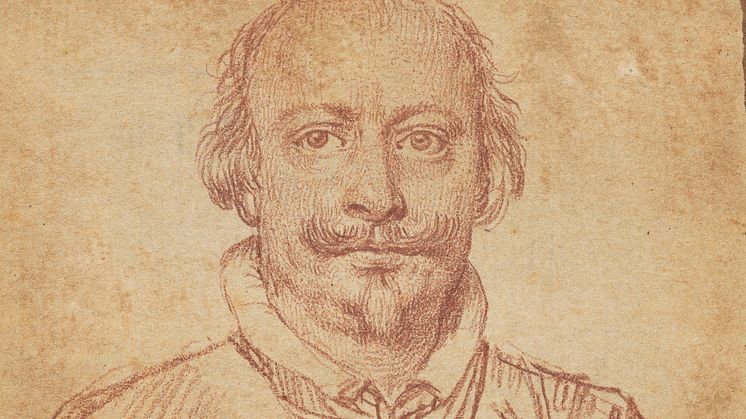
Press release -
Nationalmuseum acquires portrait of Cassiano dal Pozzo
Nationalmuseum has acquired a portrait of Cassiano dal Pozzo, a prominent patron of the arts in 17th-century Rome. The drawing in red chalk was made in the 1620s by an unknown artist. There was previously only one known portrait of dal Pozzo, made about a decade later.
Cassiano dal Pozzo (1588–1657) was an art collector and an eminent figure in the cultural life of baroque-era Rome. He had a notable interest in the evolving science of archaeology, which in the 17th century was adopting new approaches and methods to study Rome’s classical heritage. Despite limited financial resources, dal Pozzo was also one of Rome’s leading patrons of contemporary arts. His close friends included the astronomer Galileo Galilei and the painter Nicolas Poussin.
The portrait acquired by Nationalmuseum was previously unknown. A drawing in red chalk, it depicts a middle-aged man with an alert gaze, thinning hair, a handlebar moustache and a goatee beard. The face is meticulously drawn, with short lines, dots and fine details, while the shoulders and chest area are more sketchlike. A round shirt collar protrudes above a cloak of sorts fastened with a long cord. A cross is visible on the cloak, indicating that dal Pozzo was a member of the noble order of Saint Stephen.
“We don’t know the artist’s identity, but this is a vivid, high-quality drawing, even though it’s a little the worse for wear. Cassiano dal Pozzo had many artist friends and in particular was a patron of the French painters living in Rome, so there are many potential candidates to consider when it comes to identifying the artist. The only previously known portrait of Cassiano is a painting by the Flemish artist Jan van den Hoecke”, said Martin Olin, director of collections at Nationalmuseum.
The van den Hoecke portrait depicts Cassiano roughly a decade older but lacks the immediacy of the drawing now acquired by Nationalmuseum. The acquired drawing is mounted on a wooden panel, on the reverse of which one of its past owners is named. In the inscription on the panel, Cassiano dal Pozzo is mistaken for his uncle, which may be one reason why the portrait was previously unknown.
Nowadays, Cassiano dal Pozzo is best known as the founder of the Museo Cartaceo, the “paper museum”: a massive, encyclopedic project in which dal Pozzo commissioned thousands of drawings of practically all known remains from ancient Rome, including everyday objects, as well as various natural objects such as shells, mushrooms, animals and plants. These drawings, now divided between the British royal collection and other institutions in the UK and France, are currently being catalogued in a multi-volume publication as part of an international collaborative project.
Nationalmuseum receives no state funds with which to acquire design, applied art and artwork; instead the collections are enriched through donations and gifts from private foundations and trusts. The acquisition was funded by a generous donation from the Hedda and N.D. Qvist Memorial Fund.
Inventory number
Unknown artist, Portrait of Cassiano dal Pozzo (1588–1657), 1620s. Red chalk on paper, mounted on wood. NMH 208/2023.
Media contacts
Martin Olin, director of collections, martin.olin@nationalmuseum.se, +46 8 5195 4310
Hanna Tottmar, head of press, press@nationalmuseum.se, +46 8 5195 4400
Categories
Nationalmuseum is Sweden’s museum of art and design. The collections comprise some 700 000 objects, including paintings, sculpture, drawings and graphic art from the 16th century up to the beginning of the 20th century and the collection of applied art and design up to the present day. Nationalmuseum is a government authority with a mandate to preserve cultural heritage and promote art, interest in art and knowledge of art.

